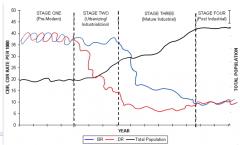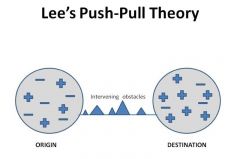![]()
![]()
![]()
Use LEFT and RIGHT arrow keys to navigate between flashcards;
Use UP and DOWN arrow keys to flip the card;
H to show hint;
A reads text to speech;
24 Cards in this Set
- Front
- Back
|
Annual Growth Rate
|
The growth rate every year
|
|
|
Crude Birth Rate (CBR)
|
Are statistical values that can be utilized to measure the growth or decline of a population (the number of birth rate per 1000 a year) from 15-49
|
|
|
General Fertility Rate (GFR)
|
General ratio of live births in an area to the population of that area (per 1000 woman)
|
|
|
Age Specific Birth Rate (ASBR)
|
When a rate, such as birth rate, incident rate, or morality rate is calculated for individuals of a specified age (or age range) then rate is described as being age specific
|
|
|
Standardised birth rate (SBR)
|
When comparing birth rates overtime, or between countries, to take account of differences in the ages structures of the population
|
|
|
Total Fertility Rate (TFR)
|
Total birth per a women
|
|
|
Demographic Transition Model
|

Stage one: Pre-modern
Stage two: Urbanizing/ industrializing Stage three: Mature industrial Stage Four: Post Industrial |
|
|
Population Pyramids
|
Stage 1: Concave Sides
Stage 2: Expansive Stage 3: Stationary Stage 4: Contractive/ Convex Sides |
|
|
Older Dependency Ratio
|
Old age dependency ratio is the indicator that is defined as thee ratio between the (project) total number of elderly persons (age 65 and over) and projected number of person of working age (from 15-64)
- Formula: % population aged 65+/ population of aged 15-64 Ex:Japan |
|
|
Youthful Population
|
Zimbabwe
|
|
|
Total Dependency Ratio
|
(number of people aged 0-14 and those aged 65+/ number of people aged 15-64) times by 100
|
|
|
Population Momentum
|
Refers to population growth or decline which countries despite fertility rates falling or increasing
|
|
|
Population Projection
|
Is an estimate/ prediction of a future population
|
|
|
Natural Increase
|
Birth rate is higher than death rate
|
|
|
Infant Mortality
|
Die before year of age
|
|
|
Population Density
|
Number of people per m2
|
|
|
Population Policies
|
Pro-natalist e.g. Singapore
Anti-natalist e.g. China |
|
|
Migration
|
The movement of people, involving a change of residence. It can be internal or external (international) and voluntary or forced. It does not include temporary circulation such as commuting or tourism
+ Migrant: a person who migrate + Immigrant: a person who comes to live permanently in a foreign country + Emigrant: a person who leaves their own country to settle permanently in another +Voluntary + Permanent + Temporary + Forced |
|
|
Push and Pull Theory
|

o Economic e.g. Singapore
o Forced e.g. Dafur, Sudan o Rural – Urban e.g. Papua New Guinea |
|
|
Remittances
|
Transfer of money/ goods by foreign workers to their home countries
|
|
|
Refugee
|
A person fleeing their home country in order to escape danger
|
|
|
Asylum Seekers
|
People who seek refugee status in another country
|
|
|
Illegal Immigrants
|
People who enters another country without permission and plan to remain there
|
|
|
Internally Displaced People (IDPs)
|
Those who have fled their homes but continue to live in their own countries
|

